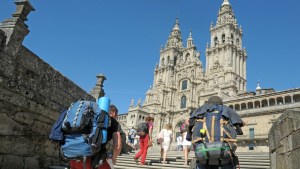The bones of a 9th-century bishop who was instrumental to the establishment of the Camino de Santiago pilgrimage route are believed to have been identified about 70 years after they were discovered. The research team conducting the investigation is 98% sure they have identified the remains of Bishop Teodomiro of Iria Flavia.
Smithsonian Magazine reports that the team called Bishop Teodomiro “the most important figure associated with the pilgrimage to Santiago de Compostela,” just after St. James the Apostle. As tradition has it, Bishop Teodomiro was the one who discovered the tomb of St. James, whose body was taken to Spain for burial after his death in Jerusalem between AD 41 – 44.
Guided by a hermit’s tale of “a shower of bright stars,” Bishop Teodomiro investigated the site of the occurrence only to find a tomb with remains he identified as St. James. The discovery led the Asturian king, Alfonso II, to travel to the tomb on a journey that would become known as the first Camino de Santiago, and at his arrival he ordered a church to be built around the remains.
The remains of Bishop Teodomiro, however, were not discovered until 1955, when they were found in a tomb marked with the bishop’s name. While the inscription was clear, analyses of the bones varied, with some disputing the gender of the deceased. These questions would endure until the most recent analysis, which employed methods such as “osteoarchaeology, radiocarbon dating, stable isotope and ancient DNA analyses,” for the study.
The results identified the bones as belonging to a middle-aged man of at least the age of 45. Consistent with the life-style of high-ranked clergy of the era, his remains show little evidence of strenuous physical work during his lifetime. Furthermore, his DNA makeup was found to be “consistent with someone living in Spain 1,200 years ago.”
The researchers are almost positive that they have their man, going so far as to cite their certainty at around 98%. If they are correct, it would make the bishop the “oldest identified historical figure in Spain, and one of the oldest in Europe.”


